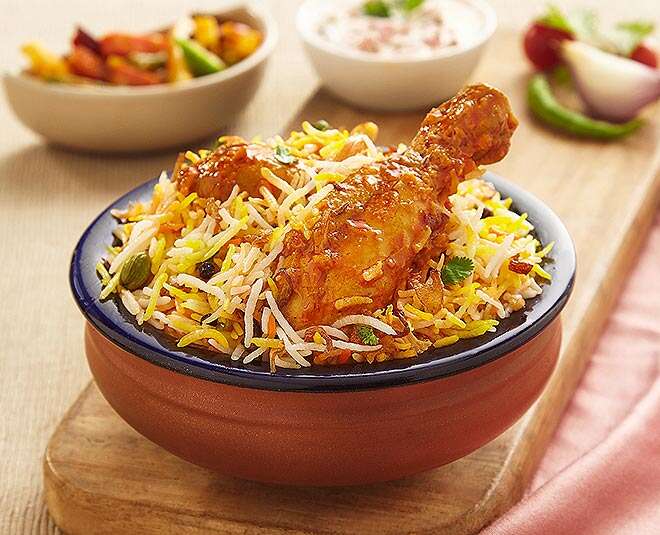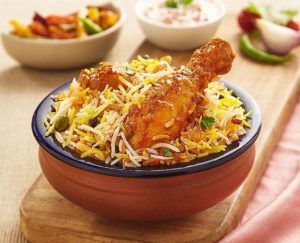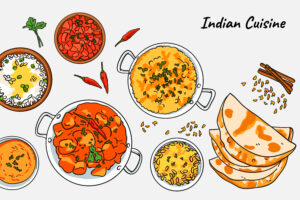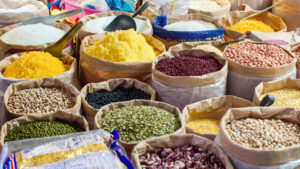From Naan to Biryani: Exploring the Culinary Delights of Indian Cuisine Restaurants
Indian cuisine is as diverse as the country itself, with each region boasting its own unique flavors and culinary traditions. From the spicy curries of the south to the rich gravies of the north, there is no shortage of delicious dishes to choose from. Let’s take a closer look at some of the most popular Indian dishes and their regional origins.

Step into the vibrant world of Indian cuisine restaurants and immerse yourself in a flavorful journey that will tantalize your taste buds. From the fragrant spices of garam masala to the mouthwatering delights of butter chicken and the soft, pillowy naan bread, Indian cuisine offers a kaleidoscope of flavours and textures that is sure to leave you wanting more.
With its rich culinary heritage and diverse regional dishes, Indian cuisine restaurants are a haven for food lovers who appreciate the art of cooking. Whether you’re craving the fiery heat of the biryani or the creamy indulgence of a mango lassi, these establishments are dedicated to serving up authentic and delectable dishes that capture the essence of India.
Experience the vibrant colours, aromatic spices, and warm hospitality that comes with every plate served at Indian cuisine restaurants. From traditional family recipes passed down through generations to innovative modern twists, these establishments offer something for everyone. So, come, indulge in the irresistible flavours of Indian cuisine and embark on a gastronomic adventure unlike any other.
Popular Indian dishes and their regional origins
Indian cuisine is as diverse as the country itself, with each region boasting its own unique flavors and culinary traditions. From the spicy curries of the south to the rich gravies of the north, there is no shortage of delicious dishes to choose from. Let’s take a closer look at some of the most popular Indian dishes and their regional origins.
In the northern region of India, you will find classics such as butter chicken, dal makhani, and tandoori chicken. These dishes are known for their rich, creamy gravies and the use of aromatic spices like cardamom and cloves. The cuisine of the south, on the other hand, is characterized by its use of coconut, curry leaves, and mustard seeds. Some popular dishes from this region include dosa, idli, and sambar.
Moving to the western part of India, you will encounter the flavors of Gujarat and Rajasthan. Gujarati cuisine is predominantly vegetarian, with dishes like dhokla, kadhi, and the famous Gujarati thali stealing the show. Rajasthan, on the other hand, is known for its royal cuisine, with dishes like laal maas, dal baati churma, and gatte ki sabzi showcasing the rich flavors of the region.
In the eastern region, the cuisine of West Bengal takes center stage with its famous fish curries, like macher jhol and shorshe ilish. The use of mustard oil and panch phoron (a mixture of five spices) gives these dishes their distinct flavor. Moving further east, you will find the flavors of Assam, with dishes like masor tenga (sour fish curry) and xaak aru bhaji (leafy greens) being the highlights.
With such a vast array of regional dishes to choose from, Indian cuisine restaurants offer a culinary journey that will take you from the snow-capped peaks of the Himalayas to the sun-drenched beaches of Goa. Each dish tells a story, reflecting the rich cultural heritage and traditions of the region it hails from. So, next time you visit an Indian cuisine restaurant, don’t be afraid to explore the diverse flavors that India has to offer.
Vegetarian and non-vegetarian options in Indian cuisine
Indian cuisine is a paradise for both vegetarians and non-vegetarians alike. With its wide range of vegetarian dishes, India has a long-standing tradition of vegetarianism that dates back centuries. From lentils and vegetables to paneer (Indian cottage cheese) and tofu, there is no shortage of delicious and nutritious options for vegetarians.
One of the most popular vegetarian dishes in Indian cuisine is dal, which is made from lentils and flavored with a variety of spices. It is a staple in every Indian household and is often served with rice or bread. Another vegetarian favorite is aloo gobi, a dish made with potatoes and cauliflower, cooked with spices like turmeric, cumin, and coriander.
For those who prefer non-vegetarian options, Indian cuisine offers a wide variety of meat and seafood dishes. From the succulent kebabs of Lucknow to the spicy fish curries of Kerala, there is something to satisfy every meat lover’s palate. Some popular non-vegetarian dishes include chicken tikka masala, butter chicken, and rogan josh.
Indian cuisine also offers a unique blend of flavors through fusion dishes that combine both vegetarian and non-vegetarian ingredients. For example, paneer tikka is a popular appetizer made from marinated paneer and grilled to perfection. Similarly, butter chicken pizza combines the flavors of the classic Indian dish with the beloved Italian staple.
Whether you’re a vegetarian, a meat lover, or someone who enjoys the best of both worlds, Indian cuisine restaurants have a wide selection of dishes to cater to your preferences. So, the next time you’re dining out, don’t hesitate to explore the diverse and delicious options that Indian cuisine has to offer.
Spices and flavors in Indian cooking
One of the defining features of Indian cuisine is its use of spices. From the fiery heat of chili powder to the warm aroma of cinnamon, Indian cooking is a symphony of flavors that will awaken your senses. Let’s take a closer look at some of the key spices and flavors that make Indian cuisine so unique.
Garam masala is a blend of ground spices that is commonly used in Indian cooking. It typically includes cinnamon, cardamom, cloves, cumin, coriander, and black pepper. This aromatic spice blend adds depth and complexity to dishes like biryani, curry, and kebabs.
Turmeric is another essential spice in Indian cuisine. Known for its vibrant yellow color, turmeric has both culinary and medicinal properties. It adds a warm, earthy flavor to dishes and is often used as a natural food coloring agent. Turmeric is also believed to have anti-inflammatory and antioxidant properties.
Cumin is a versatile spice that is used in both whole and ground form in Indian cooking. It has a warm, nutty flavor and is often paired with coriander to create a base for curries and stews. Cumin seeds are also commonly used as a tempering agent in Indian dishes, adding a burst of flavor when fried in hot oil or ghee.
Cardamom is a highly aromatic spice that is used in both sweet and savory dishes. It has a distinct, slightly sweet flavor and is often used to flavor desserts like kheer and gulab jamun. Cardamom is also a key ingredient in masala chai, a popular Indian tea infused with spices like ginger, cinnamon, and cloves.
In addition to these spices, Indian cuisine also incorporates a wide range of flavors like tangy tamarind, creamy coconut milk, and sour yogurt. These ingredients add complexity and balance to dishes, creating a harmonious blend of flavors that is unique to Indian cooking.
So, the next time you’re dining at an Indian cuisine restaurant, take a moment to appreciate the artistry behind the spices and flavors that make each dish a true masterpiece. From the delicate balance of spices to the bold flavors that burst in your mouth, Indian cuisine is a celebration of taste and aroma that will leave you craving for more.
The cultural significance of food in Indian cuisine
In Indian culture, food is more than just sustenance; it is a way of life. From religious rituals to social gatherings, food plays a central role in every aspect of Indian society. It is a reflection of the country’s rich cultural heritage and a means of connecting with one’s roots. Let’s explore the cultural significance of food in Indian cuisine.
In India, cooking is often seen as an art form, with recipes being passed down from generation to generation. Traditional family recipes are treasured and are often prepared with great care and love. Food is used to celebrate special occasions and festivals, with elaborate feasts being prepared to honor the gods and bring people together.
In Hinduism, the majority religion in India, food has a deep spiritual significance. It is believed that the food we eat directly affects our mind, body, and soul. Vegetarianism is widely practiced as a means of practicing ahimsa, or non-violence towards all living beings. Many Hindus also follow specific dietary guidelines based on their caste or religious beliefs.
Food is also a means of hospitality and generosity in Indian culture. Guests are treated with utmost respect and are often served a wide variety of dishes to ensure they have a memorable dining experience. It is considered impolite to refuse food offered by your host, as it is seen as a gesture of friendship and goodwill.
Indian cuisine is also deeply rooted in Ayurveda, an ancient Indian system of medicine. Ayurveda emphasizes the importance of balancing the three doshas (vata, pitta, and kapha) through diet and lifestyle. Certain foods are believed to have specific healing properties and can be used to treat various ailments.
Overall, food is an integral part of Indian culture, serving as a means of nourishment, celebration, and connection. It is a reflection of the country’s rich history, diverse traditions, and deep-rooted values. So, the next time you savor a delicious Indian meal, remember the cultural significance behind every bite.
Exploring the different types of Indian bread (naan, paratha, roti)
Indian cuisine is incomplete without its wide variety of bread. From the fluffy naan to the flaky paratha, bread is an essential accompaniment to many Indian dishes. Each type of bread has its own unique texture and flavor, making it a delight to explore. Let’s take a closer look at some of the most popular types of Indian bread.
Naan is perhaps the most well-known Indian bread, and for good reason. This soft, pillowy bread is typically made with all-purpose flour, yogurt, and yeast. It is cooked in a tandoor (clay oven), giving it a slightly charred and smoky flavor. Naan is often brushed with ghee (clarified butter) and can be enjoyed plain or stuffed with ingredients like garlic, cheese, or minced meat.
Paratha is a flaky, layered bread that is made by folding and rolling dough with ghee or oil. It is cooked on a hot griddle, resulting in a golden, crispy exterior. Parathas can be plain or stuffed with a variety of fillings like potato, paneer, or spinach. They are often served with a side of yogurt or pickle and are a popular breakfast option in many parts of India.
Roti, also known as chapati, is a staple in every Indian household. It is made from whole wheat flour and water, and is cooked on a hot griddle. Unlike naan or paratha, roti is not leavened, making it a healthier and lighter option. Rotis are typically enjoyed with curries or dal, and are often used to scoop up food instead of using utensils.
Puri is a deep-fried bread that is popular in North India. It is made from whole wheat flour and is often served with potato curry or chole (chickpea curry). Puris are light and crispy, making them a favorite among both adults and children. They are often enjoyed during festivals and special occasions.
These are just a few examples of the wide variety of bread that Indian cuisine has to offer. Each type of bread has its own unique flavor and texture, making it a delight to explore. So, the next time you’re dining at an Indian cuisine restaurant, don’t forget to indulge in the delicious bread that accompanies your meal.
Traditional Indian desserts and sweets
No Indian meal is complete without a sweet ending. Indian cuisine is famous for its wide variety of desserts and sweets, each offering a unique blend of flavors and textures. From creamy rice pudding to syrup-soaked gulab jamun, let’s take a closer look at some traditional Indian desserts.
Gulab jamun is perhaps the most iconic Indian sweet. These deep-fried dumplings are made from milk solids, known as khoya, and are soaked in a sugar syrup flavored with cardamom and rose water. Gulab jamuns are soft, melt-in-your-mouth treats that are often enjoyed warm with a scoop of ice cream or a dollop of rabri (sweetened condensed milk).
Kheer is a creamy rice pudding that is flavored with cardamom, saffron, and nuts. It is made by simmering rice and milk together until they thicken and develop a rich, velvety consistency. Kheer is often garnished with slivered almonds and pistachios, adding a delightful crunch to each spoonful.
Jalebi is a popular sweet that is made by deep-frying a fermented batter of all-purpose flour and yoghurt. The fried spirals are then soaked in sugar syrup, resulting in a sticky, syrupy texture. Jalebis are often enjoyed warm with a cup of masala chai and are a favourite street food snack in India.
Rasgulla is a Bengali sweet made from cottage cheese balls that are cooked in sugar syrup. The cheese balls are light and spongy, soaking up the syrup and becoming incredibly juicy. Rasgullas are often served chilled and are a refreshing dessert option, especially during the hot summer months.
These are just a few examples of the wide variety of desserts and sweets that Indian cuisine offers. Each region of India has its unique specialities, ranging from the milk-based sweets of Bengal to the nutty delights of Rajasthan. So, the next time you’re dining at an Indian cuisine restaurant, don’t forget to save room for dessert and indulge in the sweet flavours of India.
Must-try dishes in Indian cuisine restaurants
With such a vast array of dishes to choose from, it can be overwhelming to decide what to order at an Indian cuisine restaurant. To help you navigate the menu, here are some must-try dishes that are sure to delight your taste buds.
Butter chicken, also known as murgh makhani, is a classic Indian dish that is loved by people all over the world. It consists of succulent pieces of chicken cooked in a rich, creamy tomato gravy. The dish is flavoured with a blend of spices like garam masala, fenugreek leaves, and ginger-garlic paste. Butter chicken is typically served with naan or rice and is a crowd-pleaser.
Biryani is another must-try dish that is a celebration of flavours. This fragrant rice dish is made by cooking long-grain basmati rice
Conclusion and final thoughts
Indian cuisine is a treasure trove of mouthwatering dishes that will leave you spoilt for choice. Here are some must-try dishes that are sure to delight your taste buds:
1. Butter Chicken
Butter chicken, also known as murgh makhani, is a quintessentially Indian dish that is loved by people all over the world. This creamy and flavorful curry is made with tender chicken cooked in a rich tomato-based gravy, infused with aromatic spices like garam masala and fenugreek. The dish is finished off with a generous dollop of butter and cream, giving it a luscious and indulgent taste. Pair it with naan bread or fragrant basmati rice for a truly satisfying meal.
2. Biryani
Biryani is a fragrant and flavorful rice dish that is a staple in Indian cuisine. This one-pot wonder is made by layering fragrant long-grain basmati rice with marinated meat or vegetables, and cooking it all together with aromatic spices like cumin, cardamom, and saffron. The result is a dish that is bursting with flavors and has a perfect balance of spices. Each region in India has its own unique variation of biryani, making it a culinary adventure in itself.
3. Masala Dosa
Masala dosa is a popular South Indian dish that has gained popularity worldwide. It is a crispy and savory pancake made from fermented rice and lentil batter, filled with a spiced potato filling. The dosa is typically served with coconut chutney and sambar, a flavorful lentil soup. The combination of the crispy dosa, the creamy potato filling, and the tangy chutney creates a perfect harmony of flavors and textures.







